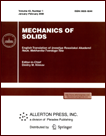 | | Mechanics of Solids
A Journal of Russian Academy of Sciences | | Founded
in January 1966
Issued 6 times a year
Print ISSN 0025-6544
Online ISSN 1934-7936 |
Archive of Issues
| Total articles in the database: | | 13288 |
| In Russian (Èçâ. ÐÀÍ. ÌÒÒ): | | 8164
|
| In English (Mech. Solids): | | 5124 |
|
| << Previous article | Volume 60, Issue 2 / 2025 | Next article >> |
| O. El Mrimar, Z. El Haddad, O. Bendaou, and B. Samoudi, "Covariance Matrix Adaptation Evolution Strategy for Optimizing Truss Structures with Discrete Variables," Mech. Solids. 60 (2), 1194-1207 (2025) |
| Year |
2025 |
Volume |
60 |
Number |
2 |
Pages |
1194-1207 |
| DOI |
10.1134/S0025654424607055 |
| Title |
Covariance Matrix Adaptation Evolution Strategy for Optimizing Truss Structures with Discrete Variables |
| Author(s) |
O. El Mrimar (Optics, Materials and Systems Team, FS, Abdelmalek Essaadi University, Tetouan, 93002 Morocco, ouadieelmrimar@gmail.com)
Z. El Haddad (Optics, Materials and Systems Team, FS, Abdelmalek Essaadi University, Tetouan, 93002 Morocco, zakaria_elhaddad@hotmail.fr)
O. Bendaou (Optics, Materials and Systems Team, FS, Abdelmalek Essaadi University, Tetouan, 93002 Morocco, o.bendaou@uae.ac.ma)
B. Samoudi (Optics, Materials and Systems Team, FS, Abdelmalek Essaadi University, Tetouan, 93002 Morocco, b.samoudi@uae.ac.ma) |
| Abstract |
This article presents an optimization approach utilizing the Covariance Matrix Adaptation
Evolution Strategy algorithm (CMA-ES) for the optimal design of truss structures with discrete variables under various loading conditions. The model uses CMA-ES to optimize design variables, specifically the cross-sectional areas of the truss bars. Evaluation data are generated by testing different
cross-sectional configurations through structural analysis of the trusses, with the aim of minimizing
the mass of the structure while respecting stress and displacement limits. CMA-ES is then employed
to efficiently navigate the design space and identify the optimal configuration. This method was
applied to three planar and spatial truss examples, with results compared to literature studies to validate the approach’s effectiveness and robustness. The optimization results highlight the exceptional
performance of the CMA-ES algorithm in achieving optimal solutions and demonstrating efficient convergence behavior. |
| Keywords |
CMA-ES algorithm, optimization, truss structures, optimal design |
| Received |
15 December 2024 | Revised |
24 February 2025 | Accepted |
25 February 2025 |
| Link to Fulltext |
|
| << Previous article | Volume 60, Issue 2 / 2025 | Next article >> |
|
 If you find a misprint on a webpage, please help us correct it promptly - just highlight and press Ctrl+Enter If you find a misprint on a webpage, please help us correct it promptly - just highlight and press Ctrl+Enter
|
|

 Russian
Russian  English
English